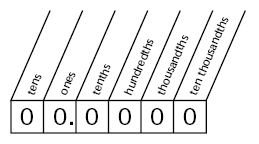|
TUTORIALS:
|
Decimals and Fractions
Many numbers you will use in science class and other places will be decimal numbers.
Like fractions, decimals are used to show how much,
or what part, of a whole. A decimal point (.) separates
the whole number part of a decimal number on the
left from the fraction part on the right. The value of a
decimal number is determined by its place value. The
chart that appears below shows the place values for the decimal
system.

The first place after the decimal point
shows parts of ten, or tenths, the second place shows
hundredths, and so on. For example, 3.74 is the same as
 . Any fraction
can be changed into a decimal number, and vice versa. . Any fraction
can be changed into a decimal number, and vice versa.
PROCEDURE: To change a fraction into a decimal, divide the numerator of the
fraction by the denominator. If you have a mixed number (a whole number with
a fraction), put the whole-number part of your number before the decimal point.
SAMPLE PROBLEM A: Change
 into a decimal number. into a decimal number.
| Step 1: Divide the numerator of the fraction by the denominator.
Notice that 20 does not divide evenly into 3. Therefore,
you will need to add zeros after a decimal point in
the numerator so that you can divide into it. The answer
will be a decimal to show what part of 20 will divide
into 3.
|
 |
Step 2: Because
 is a mixed number, put the whole
number before the decimal point. is a mixed number, put the whole
number before the decimal point. |
 |
PROCEDURE: To change a decimal into a fraction, put the decimal
over its place value and reduce.
| SAMPLE PROBLEM B: Convert 0.25 into a fraction. Because
0.25 is in the hundredths place, put 25 over 100 and reduce. |
 |
|